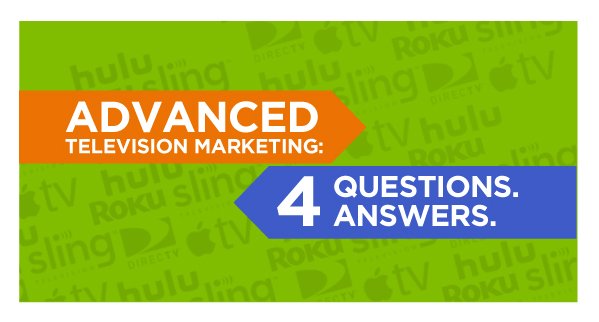Advertising in the advanced TV space has become a topic of wild debate lately, and I’m happy to weigh in on the topic. Here are the answers to four of the most common questions I’ve received so far.
What is advanced television and why should I care about it?
We in the media buying industry call it advanced television. The majority of the viewing public call it streaming, digital content, what-I-watch-on-my-phone-when-and-where-I-feel-like-it. Consumers love it because it gives them the programming they want, when they want it, without too many interruptions, fighting over channels, or network scheduling conflicts. Marketers love it because it uses addressable targeting and has huge data implications, meaning it can help companies learn more and more about a target audience and how best to position themselves in front of it.
Is advanced TV more effective than traditional TV?
The quick answer: YES, but not always in the way you might expect. Dollar for dollar, advanced TV is expensive and isn’t recommended for companies on a tight budget; however, if you have the budget for it, advanced TV has a remarkable return on investment. For one, it is growing exponentially. Secondly, it allows for highly specific targeting, so you can capture qualified leads further down the sales funnel for a higher probability of conversion. And third, it provides real, measurable data in a way that you’d never be able to squeeze from traditional television marketing efforts.
Does it deliver a larger audience than traditional TV?
Right now, no. Connected television is pretty impressive, but it’s still an up-and-coming medium for the majority of viewers. As of 2015, 65% of Americans are still plugged into their cable networks—and their traditional televisions—but it is predicted that that number will slump to just 50% by 2025.
The more important question may be this: If your huge pool of ideal customers are turned on, but not tuned in, does it really matter?
I’ve tried advertising on advanced television, but it doesn’t seem like my audience is on it nearly as much as they are with traditional. Is it still worth it?
Yes, and for the same reason we mentioned above: traditional televisions in the United States get flipped on—and stay on—regardless if someone is paying attention or not. If you can afford advanced television advertising, you are getting more than just qualified leads out of the mix; you are getting true, actionable data that will not only inform your future advertising in the connected TV space, but also your marketing efforts along every other spectrum. And, as we all know, the more you know about your ideal consumer, the better every campaign will be.
Remember, advanced TV users tune in with purpose. They are watching their favorite shows, sports teams, late night snippets, and YouTube videos. They typically aren’t flipping a switch and walking away; they are holding what they want front and center. And isn’t that where your ad should be?





